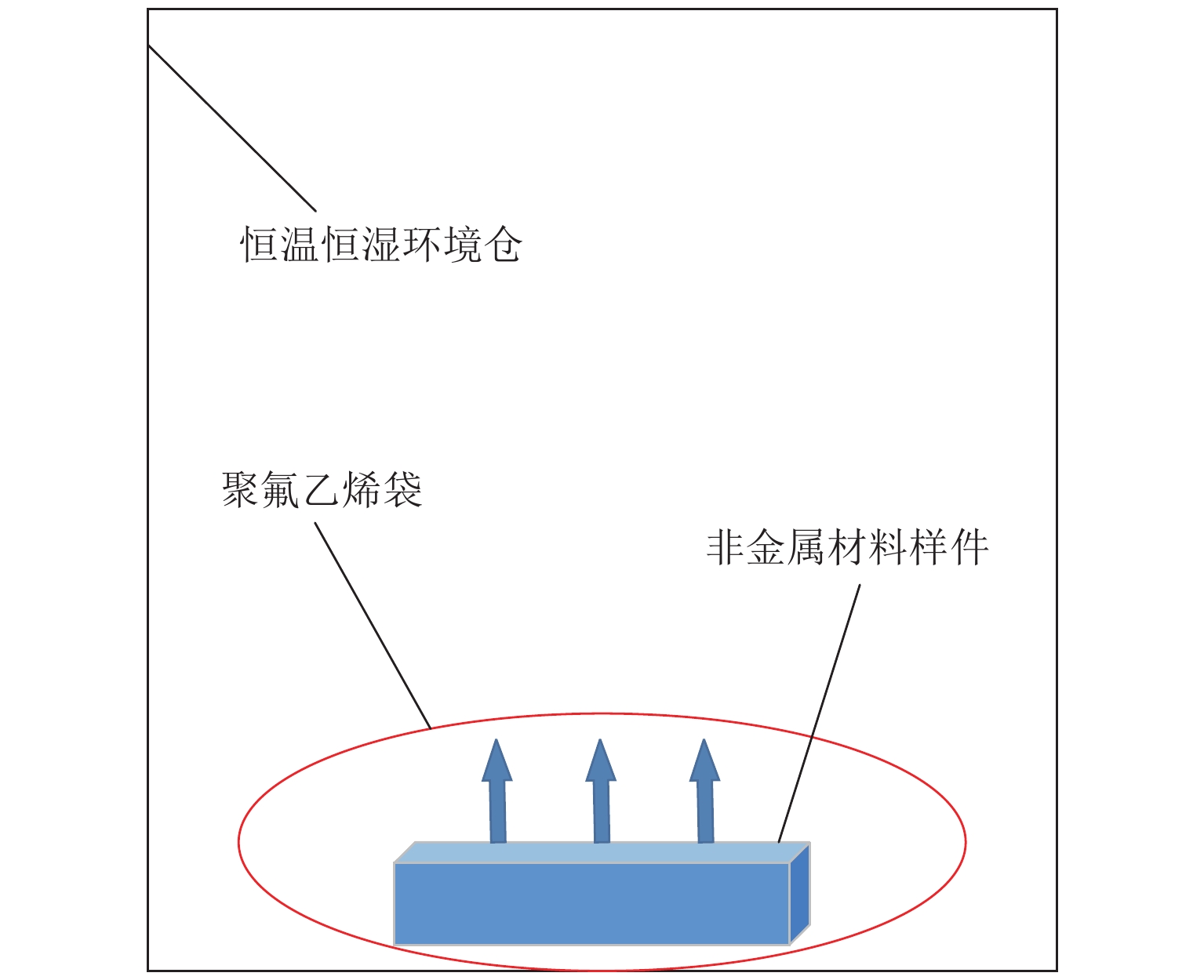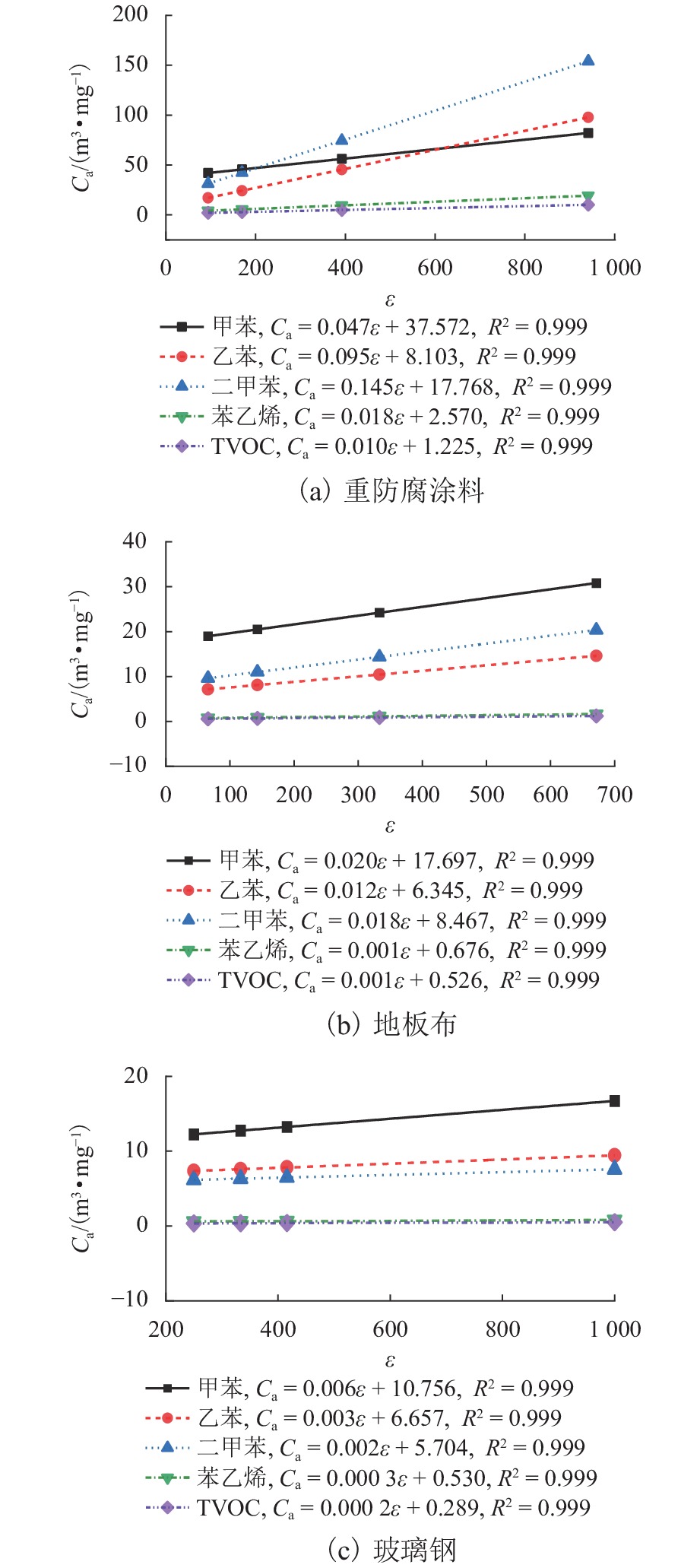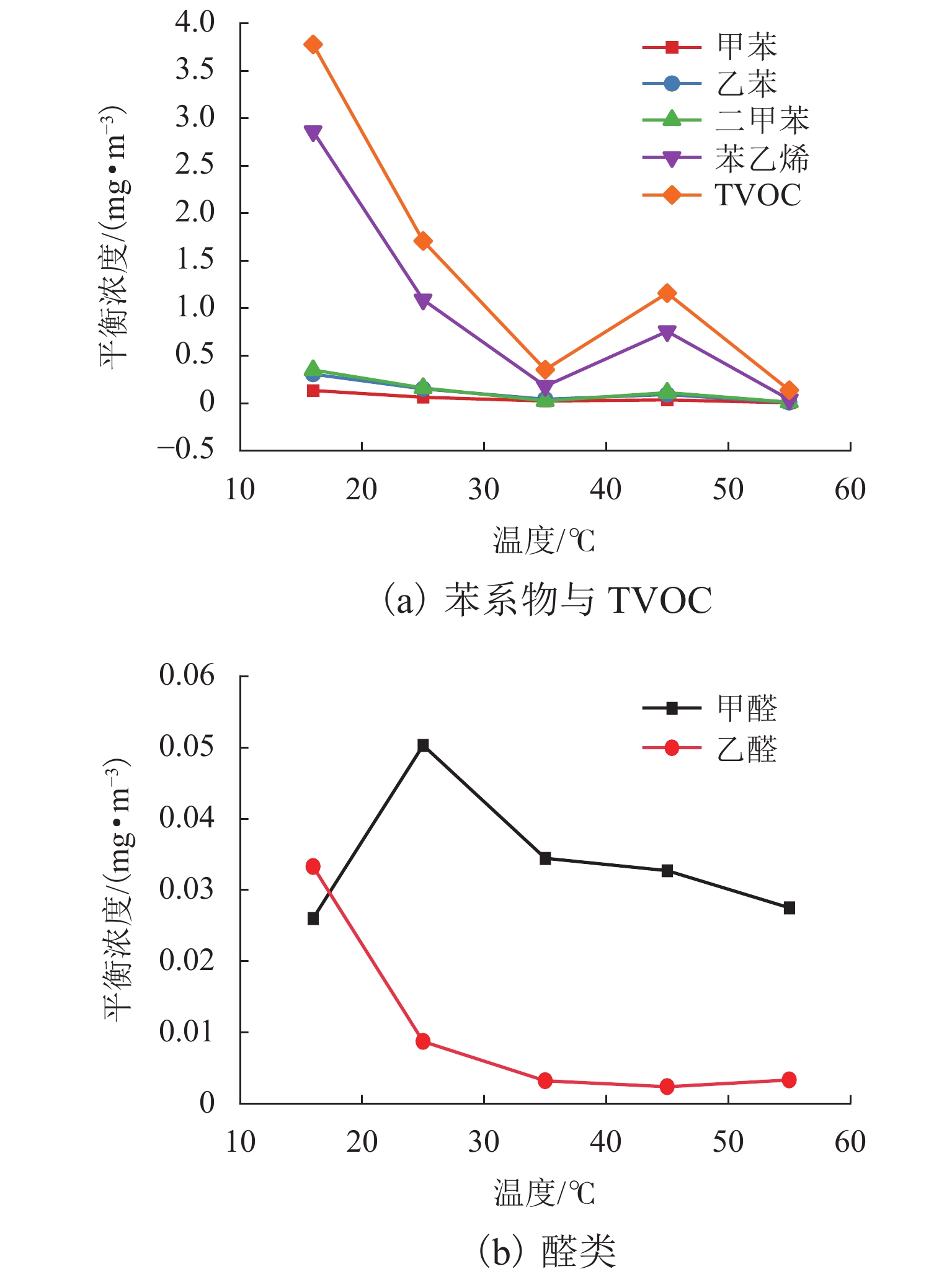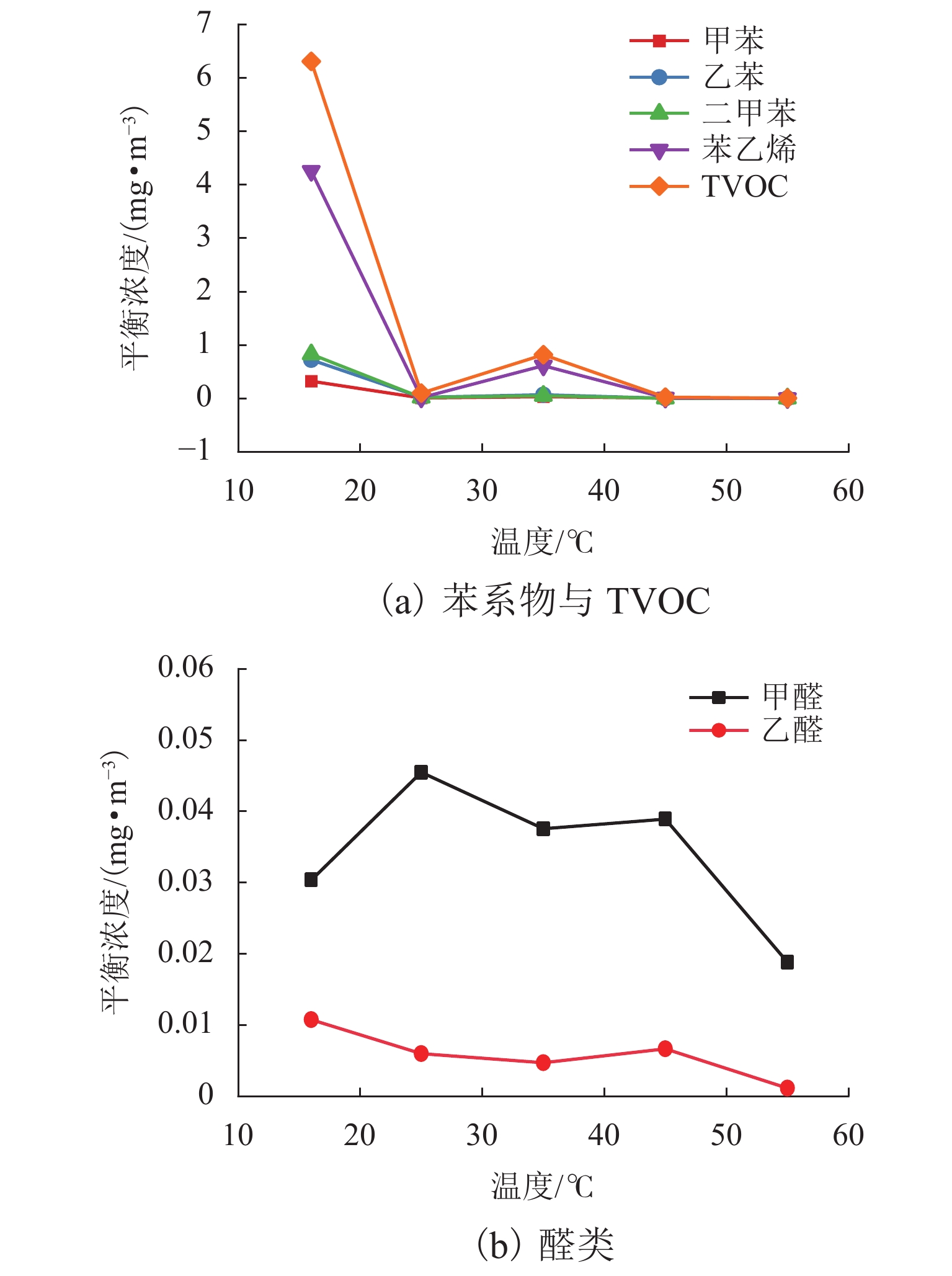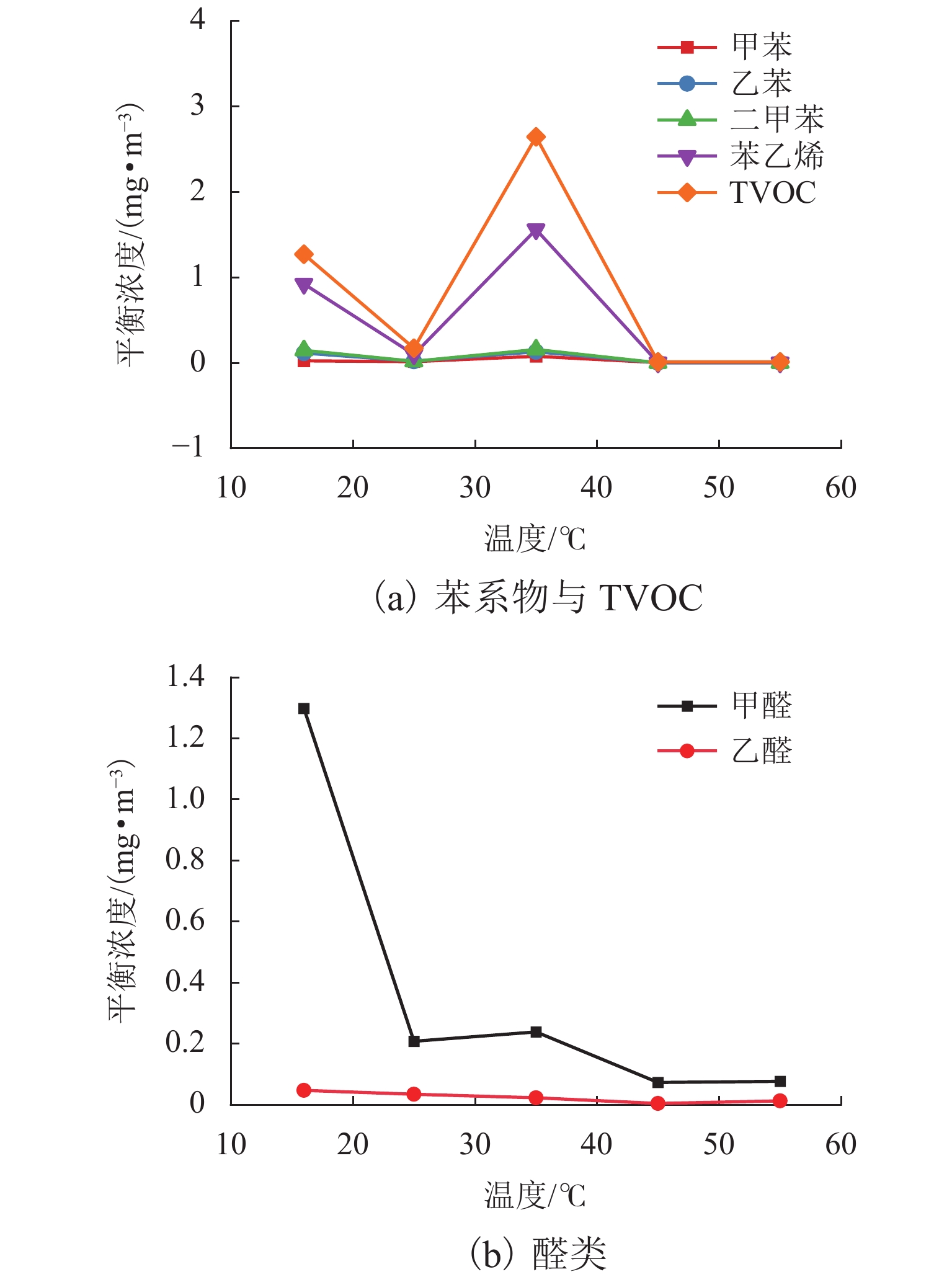Experimental Study on Emission Law of VOCs from Non-metallic Materials for Railway Passenger Trains
-
摘要:
为了研究温度对铁路客车典型非金属材料中挥发性有机化合物释放量的影响,基于多气固比法和数据拟合法,对典型非金属材料(重防腐涂料、地板布、玻璃纤维增强塑料)的挥发性有机化合物释放规律进行了试验研究. 首先,分别测量了4种不同气固比条件下的挥发性有机化合物浓度,得到挥发性有机化合物释放关键参数(初始可散发浓度和分配系数);然后,结合车辆工艺和运用场景,研究不同温度对挥发性有机化合物释放规律的影响. 研究结果表明:材质的物理化学性能和温度是影响挥发性有机化合物释放特性的重要因素;温度从16 ℃升高至55 ℃,苯系物和醛类散发浓度均呈减小的趋势,重防腐涂料的初始可散发浓度减小为1.8%,其分配系数减小,地板布和玻璃钢的初始可散发浓度减小至0.3%以下,地板布的分配系数增大,玻璃钢的分配系数减小;苯系物是挥发性有机化合物的主要成分,其中以苯乙烯占比最大,甲苯、乙苯以及二甲苯占比排序规律不明显,并且未检测出苯;在铁道车辆烘焙法环保净化处理时,建议重防腐涂料的烘焙温度不小于55 ℃,地板布和玻璃钢的烘焙温度不小于45 ℃.
Abstract:In order to study the effect of the temperature on the emission of volatile organic compounds (VOCs) from typical non-metallic materials (heavy anti-corrosion coatings, floor covering, and glassfiber reinforced plastics) for railway passenger trains, tests were carried out to analyze the emission law of VOCs based on multi-gas-solid ratio method and data fitting method. First, the concentrations of VOCs under four different gas-solid ratios were measured, and key parameters (initial emittable concentration and diffusion coefficient) influencing the emission of VOCs were obtained. Then, with the help of vehicle manufacturing technology and application scenarios, the effect of different temperatures on the emission law of VOCs was studied. The results show that the physical and chemical properties of the materials and the temperature greatly affect the emission of VOCs. When the temperature rises from 16 to 55 ℃, the concentrations of benzene compounds and aldehydes decrease; the initial emittable concentration of heavy anti-corrosion coatings is decreased to 1.8%, and its diffusion coefficient is decreased. At the same time, the initial emittable concentrations of both floor covering and glassfiber reinforced plastics are decreased to less than 0.3%; the diffusion coefficient of floor covering is increased, while that of glassfiber reinforced plastics is decreased. Benzene compounds are the main components of VOCs, in which the styrene accounts for the largest proportion, and the ranking rule of toluene, ethylbenzene, and xylene is not obvious. Meanwhile, the benzene is not detected in the test. In the baking process of railway trains for environmental protection, it is suggested that the baking temperature of heavy anti-corrosion coatings should not be less than 55 ℃, and that of floor covering and glassfiber reinforced plastics should not be less than 45 ℃.
-
截至2021年底,全国铁路营业里程突破15万公里,其中高铁突破4万公里,占比超过26%,高速铁路客运量比重达到71%以上,客运周转量比重达到59%以上, 形成了世界上最现代化的铁路网和最发达的高铁网. 铁路客车成为人们日常出行的一种重要交通工具, 同时,铁路客车微环境中的空气质量评估成为人们关注的重点问题.
铁路客车车内空气质量与车内易挥发性有机物(volatile organic compounds, VOCs)浓度有着紧密关系. VOCs超标会造成较为严重的健康风险[1-2]. 为了保证司乘人员的健康安全,国家制定了机车车辆环保标准[3],严格管控源头质量,从零部件材料和整车2个方面,对有害物质限量提出了指标要求. 工程实际中,除材料源头管控外,制造工序的VOCs处理同样重要[4]. 铁路客车车内VOCs来源广泛,其中,重防腐涂料、地板布以及玻璃纤维增强塑料(简称玻璃钢)用量大、有气味、可长期释放VOCs,成为车内VOCs释放的典型非金属材料[5],因此,重防腐涂料、地板布以及玻璃钢的环保处理成为铁路客车环保源头管控和制造工序管控的重要内容. 目前,铁路客车非金属材料的VOCs处理主要采用“加热—通风”法,此方法需要解决加热温度、通风时间、成本以及制造周期等问题. 只有掌握非金属材料的VOCs释放规律,才能解决上述工程问题. 因此,开展不同温度下的典型非金属材料VOCs释放规律研究有着积极的意义.
针对非金属材料中VOCs释放特性问题,一般采用3个关键参数进行表征[6-7]:初始可散发浓度C0,表征单位体积非金属材料能够散发到客室内环境中的VOCs总量,是对车辆用非金属材料VOCs释放水平进行评判的主要指标;扩散系数D,表征在单位浓度梯度条件下,单位时间内沿扩散方向垂直通过单位面积所传输物质的量或质量;分配系数K[8-10],表征VOCs在吸附相和气相的分配比例,K值对VOCs初期释放率影响大,对中后期释放率影响小. K值越大,客室内VOCs释放初期浓度峰值越小. 因试验数据具有直观、可靠、更接近实际的特点,使得试验方法在VOCs释放特性研究中具有不可替代的作用. Cox等[11]利用低温研磨/流化床解吸附法,研究了乙烯基地板材中的初始可散发浓度. Smith等[12]利用常温萃取法,研究了刨花板中初始可散发浓度. 低温研磨/流化床解吸附法和常温萃取法均对试验样件进行了粉碎,以提高试验样件中VOCs散发速率,但此方法可能破坏了试验样件的物理和化学性能,无法代表材料的真实状态. Bodalal等[13]设计了双舱法,分别对室内地毯、乙烯基地板以及胶合板中D和K进行了研究. Blondeau等[14]利用孔隙率方法,研究了7种建筑材料中的D. Liu等[15]利用微天平法,研究了不同温度和相对湿度条件下的VOCs释放规律,发现D、K与相对湿度无关,随着温度升高,D值增大,K减小. Xiong等[16]提出了密闭舱C-history法,对建筑材料中的3个特征参数进行了测试分析,相对误差小于10%,同时,此方法试验周期短,满足工程应用需求. Xu等[17]提出一种遍历法,对多层皮革的3个特性参数进行了测试分析,发现温度升高导致D增大,K减小. 王海媚等[18]利用直流舱C-history法,同时对乘用车的地毯、顶棚以及座椅的VOCs释放关键参数进行了分析与预测,建立了多源释放模型. 杨韬等[19-20]基于直流舱C-history法,分别研究了乘用车内部材料的VOCs和半挥发性有机化合物(SVOC)的散发关键参数. 综上所述,VOCs释放规律的研究主要集中在建筑材料和乘用车内部非金属材料,对铁路客车用非金属材料的VOCs释放规律问题研究较少.
本文以铁路客车用典型非金属材料(重防腐涂料、地板布、玻璃钢)为研究对象,采用多气固比法[6]对不同温度条件下的总挥发性有机物(TVOC)浓度、TVOC主要成分进行了测试分析,提出了烘焙法净化处理温度,结合数据拟合法,获取了VOCs的初始可散发浓度,分配系数. 本文的研究成果可为今后进一步开展铁路客车的环保管控提供参考.
1. 试验简介
1.1 试验设备
气固比是指密闭环境中空气体积与测试样件体积的比值. 本试验在恒温恒湿环境仓(图1)中进行,将装载非金属材料样件的聚氟乙烯(PVF)薄膜袋放置于恒温恒湿环境仓中,实现温度和相对湿度的调节与稳定. 同时,通过改变样件数量,实现不同气固比条件下的VOCs平衡浓度测量. 表1列出了试验中的主要设备名称与型号.
表 1 试验设备Table 1. Experimental equipment设备名称 型号规格 聚氟乙烯(PVF)薄膜袋 100 L 氮气 体积分数不小于99.99% 恒温恒湿环境仓 DNF-500A 大气采样仪 QC-2B双路 2,6-二苯呋喃多孔聚合
物树脂(porous polymer 2,6-diphenyl
furan resin, Tenax-TA)采样管200 mg 2,4-二硝基苯肼(2,4-dinitrophenyl
hydrazine, DNPH)采样管300 mg/mL 质谱联用仪(GC-MS/MS) EXPEC 5231 气相色谱 高效液相色谱仪 EX1600 1.2 试验材料制备
本文的测试对象是某型铁路客车二等座车的非金属材料,此车型车体内表面面积约为280 m2;重防腐涂料涂装面积约为280 m2;地板布铺装面积约为70 m2;玻璃钢安装面积约为130 m2. 此3种非金属材料最常见且用量较大,可代表铁路客车非金属材料. 其中,重防腐涂料属于双组份环氧重防腐,其制作工艺为环境温度(20±1) ℃,相对湿度50%±10%,重防腐单涂层平均厚度为150~200 μm,附着力≤1级,对涂层进行强制干燥,温度为(60±2) ℃,干燥时间为3 h.
地板布和玻璃钢从产品中取样:选取同一批次、同一类别、同一规格的样品,取样位置距离样品边缘不小于10 cm;不允许进行任何正式生产工艺之外的预处理或后处理;样品应保证平行样之间尺寸、批次的一致性;样品表面不得被马克笔书写、贴标签或缠绕胶带.
1.3 试验参数
同一温度条件下,每种非金属材料进行4种不同气固比条件下的VOCs浓度测试分析,确定初始可散发浓度C0及分配系数K. 共开展5种温度(16、25、35、45、55 ℃)条件下的VOCs释放关键参数测试. 每个测试工况的恒温处理时间均为(24±1) h. 测试工况见表2,其中,实车气固比是指车辆实际运营状态下的气固比.
表 2 测试工况Table 2. Experimental conditions测试材料 测试
温度/℃气固比 实车气
固比重防腐
涂料16、25、
35、45、55941.2、392.2、170.0、94.1 170.0 地板布 671.4、333.3、142.9、65.8 617.4 玻璃钢 1000.0、416.0、333.3、250.0 416.0 1.4 VOCs测试
步骤1 烘焙处理. 将测试样件放置于恒温恒湿环境仓中,恒温烘焙,持续时间(24±1) h.
步骤2 清洗制样. 将试验样品放入老化好的采样袋中,并充入其容积30%的高纯氮气; 密封后,使用隔膜真空泵清洗采样袋,重复操作2次; 清洗完后向采样袋中充入其容积50%的高纯氮气.
步骤3 将采样袋放入于温度(23±2) ℃,湿度(50±5) %的恒温恒湿环境仓,静置16 h.
步骤4 用Tenax-TA管采集苯系物和总挥发性有机化合物,用DNPH采样管采集醛类物质. 其中,Tenax-TA采样管采集流量为500 mL/min,采集时间为15 min;DNPH采样管采集流量为500 mL/min,采集时间为15 min.
步骤5 采用气相色谱法进行苯系物和总挥发性有机化合物分析;采用高效液相色谱法(HPLC)进行醛类物质分析.
苯、甲苯、乙苯、二甲苯以及苯乙烯的检出限为0.004 mg/m3. 甲醛、乙醛的检出限为0.005 mg/m3.
2. 试验结果与分析
多气固比法是基于质量守恒定律和亨利定律,测试不同气固比条件下的VOCs平衡浓度,拟合获得C0及K.
测试样件始终存放于密闭的PVF袋中,根据VOCs起始状态和平衡态总质量守恒有
C0Vm=CaVa+CmVm, (1) 式中:Vm为非金属材料样件的总体积,m3;Va为聚氟乙烯袋中氮气体积,m3;Ca为平衡后氮气中VOCs的浓度,mg/m3;Cm为平衡后非金属材料样件中VOCs浓度,mg/m3.
根据亨利定律有
K=CmCa. (2) 气固比为
ε=VaVm. (3) 由式(1)、(2)、(3)可得到
1Ca=εC0+KC0. (4) 通过多次气固比试验,利用式(4),可求得待定参数C0和K.
2.1 VOCs释放关键参数测定
基于多气固比法的测试原理,在不同气固比工况下对非金属材料样件进行试验测试,对VOCs的平衡浓度与气固比数据进行线性拟合,将线性拟合得到的斜率和截距结合式(4)求出C0和K. 以35 ℃测试工况为例,测试材料中4种苯系物(均未测得苯)及TVOC的拟合结果见图2. 图2显示:玻璃钢的TVOC拟合曲线斜率最小,当前温度条件下,其C0最大;地板布C0次之,重防腐涂料C0最小. 因此,3种非金属材料的TVOC管控优先级依次是玻璃钢、地板布、重防腐涂料. 此外,重防腐涂料对气固比相对敏感,在整车环保管控方案中,应关注重其用量.
3种测试材料在5种温度条件下的释放关键参数分别汇总于表3、4、5中,可以看出:同一温度条件下,重防腐涂料、地板布以及玻璃钢的VOCs释放关键参数差异显著,说明材质的物理化学特性影响释放关键参数的值;同一温度下,总体来讲,测试材料中苯乙烯的初始可散发浓度C0值在4种苯系物中最大,其余3种苯系物的C0排序规律不明显,以35 ℃下的重防腐涂料为例,苯乙烯的C0值是其他3种苯系物的2.7倍~8.1倍;苯系物是测试材料中TVOC主要成分,以35 ℃下的重防腐涂料为例,4种苯系物的初始可散发浓度C0值是TVOC的90.3%,实车气固比条件下,4种苯系物浓度总测试值是TVOC的75.5%,这表明C0的测试对分析整车VOCs的释放规律具有重要指导意义. 因为当温度达到45 ℃以上时,玻璃钢中的甲苯、乙苯、二甲苯以及苯乙烯测试值已小于检出限;当温度达到55 ℃以上时,地板布中的甲苯、乙苯、二甲苯以及苯乙烯测试值已小于检出限.
表 3 重防腐涂料中VOCs的释放关键参数值Table 3. Key emission parameters for VOCs in heavy anti-corrosion coatings编号 VOC 16 ℃ 25 ℃ 35 ℃ 45 ℃ 55 ℃ C0/(mg·m−3) K C0/(mg·m−3) K C0/(mg·m−3) K C0/(mg·m−3) K C0/(mg·m−3) K 1 甲苯 518.135 3725.824 61.576 835.039 21.128 793.823 23.095 502.336 6.455 1446.152 2 乙苯 390.625 1110.180 75.643 333.204 10.492 85.016 71.839 626.232 4.187 425.315 3 二甲苯 540.541 1382.216 71.839 280.830 6.913 122.833 101.523 751.252 5.675 390.967 4 苯乙烯 2917.893 850.041 558.659 343.128 56.211 144.483 729.927 795.599 46.926 1071.506 5 TVOC 4099.150 915.176 1562.500 744.719 104.932 128.583 970.874 667.942 72.098 361.066 表 4 地板布中VOCs的释放关键参数值Table 4. Key emission parameters for VOCs in floor coveringVOC 16 ℃ 25 ℃ 35 ℃ 45 ℃ 55 ℃ C0/(mg·m−3) K C0/(mg·m−3) K C0/(mg·m−3) K C0/(mg·m−3) K C0/(mg·m−3) K 甲苯 606.061 1219.267 12.133 974.328 51.125 904.766 4.318 373.513 乙苯 1154.450 932.784 99.602 4463.983 81.169 514.978 1.514 104.657 二甲苯 1261.456 853.349 36.298 1847.089 56.433 477.818 1.124 54.591 苯乙烯 7435.884 1076.419 15.359 415.293 699.301 472.664 7.343 89.615 TVOC 10360.687 971.211 189.394 1251.769 961.538 505.750 17.268 86.127 8.632 1501.000 表 5 玻璃钢中VOCs的释放关键参数值Table 5. Key emission parameters for VOCs in glassfiber reinforced plasticsVOC 16 ℃ 25 ℃ 35 ℃ 45 ℃ 55 ℃ C0/(mg·m−3) K C0/(mg·m−3) K C0/(mg·m−3) K C0/(mg·m−3) K C0/(mg·m−3) K 甲苯 52.138 1903.920 11.022 459.013 168.067 1807.793 乙苯 198.807 1348.443 12.620 293.751 359.712 2394.435 二甲苯 240.385 1249.683 13.748 448.944 537.634 3066.505 苯乙烯 1578.467 1295.969 55.066 160.374 3723.909 1973.337 TVOC 2162.751 1288.589 100.705 177.282 4668.207 1350.396 21.231 1758.985 6.831 292.682 2.2 温度对VOCs释放的影响
对于重防腐涂料,从表3可看出:当温度从16 ℃升高至55 ℃时,TVOC的C0和K均有减小的趋势;与16 ℃相比,55 ℃时,C0减小到1.8%,K减小到39.5%,说明经过24 h的恒温烘烤处理,重防腐涂料内的VOCs得到了加速释放,材料内VOCs降低,因此,烘焙法净化处理重防腐涂料可取得明显效果. 以实车气固比工况为例,随着温度的升高,苯系物和TVOC浓度呈非单调性变化[21],具体表现为先减小后增大再减小(见图3(a)). 在45 ℃时,苯乙烯浓度相对增大,同时,TVOC浓度相应增大,TVOC释放规律与苯乙烯释放规律相似. 原因可能是45 ℃时,重防腐涂料的物理化学性能发生了变化,此时温度超过苯乙烯闪点温度31.1 ℃,苯乙烯的释放量增大;温度升高至55 ℃时,经过24 h烘焙处理,重防腐涂料样件中VOCs大量释放,导致VOCs平衡浓度再次减小. 此外,醛类浓度也有减小的趋势(见图3(b)). 综合考虑醛类、苯系物以及TVOC的变化规律,重防腐涂料的烘焙法净化温度可取55 ℃左右.
对于地板布,从图4(a)可以看出,随着温度的升高,平衡浓度有降低的趋势. 结合表4,与16 ℃相比,当温度高于45 ℃时,甲苯、乙苯、二甲苯以及苯乙烯浓度已低于检出限值,TVOC平衡浓度基本不变,初始可散发浓度减小到0.2%以下,分配系数波动较大,最小约为86.127,最大约为1501.000. C0是材料VOCs释放水平的主要评判指标,C0减小,材料释放VOCs的能力降低. K对VOCs初期散发速率影响较大,K值越大,Ca的峰值越小. 同时,图4(b)显示,45 ℃以上时,醛类的平衡浓度降低. 因此,建议地板布的烘焙法净化物温度不小于45 ℃.
对于玻璃钢,温度升高对其VOCs释放规律的影响与地板布相似,45 ℃时,C0减小到1.0%以下,K值同样具有波动性. 但不同点在于,此车型应用的玻璃钢采用手糊制作工艺,产品组分的均匀性较差,因此,平衡浓度的离散性较大. 结合图5(a)和图5(b),建议玻璃钢的烘焙法净化温度不小于45 ℃. 综合来看,材质和温度均会影响释放关键参数,其变化规律取决于材料和VOCs自身的物理化学性能.
3. 结 论
1) 材质的物理化学特性和温度对VOCs的释放关键参数影响很大. 从16 ℃增加至55 ℃,且24 h恒温处理后,重防腐涂料的C0减小到1.8%,K减小;地板布和玻璃钢的C0减小到0.3%,地板布的K增大,玻璃钢的K减小.
2) 铁路客车典型非金属材料(重防腐涂料、地板布、玻璃钢)的VOCs主要成分是苯系物,其中以苯乙烯占比最大.
3) 在铁路客车典型非金属材料VOCs源头管控和车辆制造工艺中,建议重防腐涂料烘焙法净化温度不小于55 ℃,地板布和玻璃钢的烘焙法净化温度不小于45 ℃.
本研究为铁路客车非金属材料的VOCs管控提供了理论依据和技术支持.
-
表 1 试验设备
Table 1. Experimental equipment
设备名称 型号规格 聚氟乙烯(PVF)薄膜袋 100 L 氮气 体积分数不小于99.99% 恒温恒湿环境仓 DNF-500A 大气采样仪 QC-2B双路 2,6-二苯呋喃多孔聚合
物树脂(porous polymer 2,6-diphenyl
furan resin, Tenax-TA)采样管200 mg 2,4-二硝基苯肼(2,4-dinitrophenyl
hydrazine, DNPH)采样管300 mg/mL 质谱联用仪(GC-MS/MS) EXPEC 5231 气相色谱 高效液相色谱仪 EX1600 表 2 测试工况
Table 2. Experimental conditions
测试材料 测试
温度/℃气固比 实车气
固比重防腐
涂料16、25、
35、45、55941.2、392.2、170.0、94.1 170.0 地板布 671.4、333.3、142.9、65.8 617.4 玻璃钢 1000.0、416.0、333.3、250.0 416.0 表 3 重防腐涂料中VOCs的释放关键参数值
Table 3. Key emission parameters for VOCs in heavy anti-corrosion coatings
编号 VOC 16 ℃ 25 ℃ 35 ℃ 45 ℃ 55 ℃ C0/(mg·m−3) K C0/(mg·m−3) K C0/(mg·m−3) K C0/(mg·m−3) K C0/(mg·m−3) K 1 甲苯 518.135 3725.824 61.576 835.039 21.128 793.823 23.095 502.336 6.455 1446.152 2 乙苯 390.625 1110.180 75.643 333.204 10.492 85.016 71.839 626.232 4.187 425.315 3 二甲苯 540.541 1382.216 71.839 280.830 6.913 122.833 101.523 751.252 5.675 390.967 4 苯乙烯 2917.893 850.041 558.659 343.128 56.211 144.483 729.927 795.599 46.926 1071.506 5 TVOC 4099.150 915.176 1562.500 744.719 104.932 128.583 970.874 667.942 72.098 361.066 表 4 地板布中VOCs的释放关键参数值
Table 4. Key emission parameters for VOCs in floor covering
VOC 16 ℃ 25 ℃ 35 ℃ 45 ℃ 55 ℃ C0/(mg·m−3) K C0/(mg·m−3) K C0/(mg·m−3) K C0/(mg·m−3) K C0/(mg·m−3) K 甲苯 606.061 1219.267 12.133 974.328 51.125 904.766 4.318 373.513 乙苯 1154.450 932.784 99.602 4463.983 81.169 514.978 1.514 104.657 二甲苯 1261.456 853.349 36.298 1847.089 56.433 477.818 1.124 54.591 苯乙烯 7435.884 1076.419 15.359 415.293 699.301 472.664 7.343 89.615 TVOC 10360.687 971.211 189.394 1251.769 961.538 505.750 17.268 86.127 8.632 1501.000 表 5 玻璃钢中VOCs的释放关键参数值
Table 5. Key emission parameters for VOCs in glassfiber reinforced plastics
VOC 16 ℃ 25 ℃ 35 ℃ 45 ℃ 55 ℃ C0/(mg·m−3) K C0/(mg·m−3) K C0/(mg·m−3) K C0/(mg·m−3) K C0/(mg·m−3) K 甲苯 52.138 1903.920 11.022 459.013 168.067 1807.793 乙苯 198.807 1348.443 12.620 293.751 359.712 2394.435 二甲苯 240.385 1249.683 13.748 448.944 537.634 3066.505 苯乙烯 1578.467 1295.969 55.066 160.374 3723.909 1973.337 TVOC 2162.751 1288.589 100.705 177.282 4668.207 1350.396 21.231 1758.985 6.831 292.682 -
[1] 张寅平. 室内空气安全和健康: 问题、思考和建议[J]. 安全,2020,41(9): 1-10,89.ZHANG Yinping. Problems, thinking and suggestions on indoor air safety and health[J]. Safety & Security, 2020, 41(9): 1-10,89. [2] XU H M, LI Y Q, FENG R, et al. Comprehensive characterization and health assessment of occupational exposures to volatile organic compounds (VOCs) in Xi’an, a major city of northwestern China[J]. Atmospheric Environment, 2021, 246: 118085.1-118085.10. [3] 国家铁路局. 机车车辆非金属材料及室内空气有害物质限量: TB/T 3139—2021[S]. 北京: 中国铁道出版社, 2021. [4] 李少华. 高速动车组车内空气质量管控方式研究[J]. 铁道车辆,2020,58(6): 30-31,6. doi: 10.3969/j.issn.1002-7602.2020.06.013LI Shaohua. Research on control of air quality inside high speed multiple units[J]. Rolling Stock, 2020, 58(6): 30-31,6. doi: 10.3969/j.issn.1002-7602.2020.06.013 [5] 李莉,石卫兵,张兰兰,等. 轨道交通车辆车内挥发性有机化合物的管控现状及建议[J]. 城市轨道交通研究,2018,21(6): 81-84,87.LI Li, SHI Weibing, ZHANG Lanlan, et al. Current management and control of interior volatile organic compounds in rail transit vehicles and suggestions[J]. Urban Mass Transit, 2018, 21(6): 81-84,87. [6] 严伟. 建材VOCs散发关键参数测定及散发模拟研究[D]. 北京: 清华大学, 2009. [7] 周晓骏. 多孔建材VOC多尺度传质机理及散发特性研究[D]. 西安: 西安建筑科技大学, 2017. [8] LITTLE J C, HODGSON A T, GADGIL A J. Modeling emissions of volatile organic compounds from new carpets[J]. Atmospheric Environment, 1994, 28(2): 227-234. doi: 10.1016/1352-2310(94)90097-3 [9] LIU Z, YE W, LITTLE J C. Predicting emissions of volatile and semivolatile organic compounds from building materials: a review[J]. Building and Environment, 2013, 64: 7-25. doi: 10.1016/j.buildenv.2013.02.012 [10] LI M. Robust nonfitting way to determine mass diffusivity and initial concentration for VOCs in building materials with accuracy estimation[J]. Environmental Science & Technology, 2013, 47(16): 9086-9092. [11] COX S S, LITTLE J C, HODGSON A T. Measuring concentrations of volatile organic compounds in vinyl flooring[J]. Journal of the Air & Waste Management Association, 2001, 51(8): 1195-1201. [12] SMITH J F, GAO Z, ZHANG J S, et al. A new experimental method for the determination of emittable initial VOC concentrations in building materials and sorption isotherms for IVOCs[J]. Clean-Soil, Air, Water, 2009, 37(6): 454-458. doi: 10.1002/clen.200900003 [13] BODALAL A, ZHANG J S, PLETT E G. A method for measuring internal diffusion and equilibrium partition coefficients of volatile organic compounds for building materials[J]. Building and Environment, 2000, 35(2): 101-110. doi: 10.1016/S0360-1323(99)00005-0 [14] BLONDEAU P, TIFFONNET A L, DAMIAN A, et al. Assessment of contaminant diffusivities in building materials from porosimetry tests[J]. Indoor Air, 2003, 13(3): 310-318. doi: 10.1034/j.1600-0668.2003.00208.x [15] LIU Z, HOWARD-REED C, COX S S, et al. Diffusion-controlled reference material for VOC emissions testing: effect of temperature and humidity[J]. Indoor Air, 2014, 24(3): 283-291. doi: 10.1111/ina.12076 [16] XIONG J Y, YAO Y, ZHANG Y P. C-history method: rapid measurement of the initial emittable concentration, diffusion and partition coefficients for formaldehyde and VOCs in building materials[J]. Environmental Science & Technology, 2011, 45(8): 3584-3590. [17] XU B P, WANG Y Z, GUO D D, et al. Determination of the key parameters of VOCs emitted from multi-layer leather furniture using a region traversal approach[J]. Science of the Total Environment, 2022, 819: 153126.1-153126.10. [18] 王海媚,童丽萍,熊建银. 基于小环境舱测试的实际车内VOC浓度预测[J]. 北京理工大学学报,2022,42(2): 145-151. doi: 10.15918/j.tbit1001-0645.2021.129WANG Haimei, TONG Liping, XIONG Jianyin. Prediction of In-vehicle VOC concentrations based on small-scale chamber test[J]. Transactions of Beijing Institute of Technology, 2022, 42(2): 145-151. doi: 10.15918/j.tbit1001-0645.2021.129 [19] 杨韬,熊建银,郝玲. 直流舱测定材料VOC散发关键参数的浓度轨迹法[J]. 化工学报,2015,66(增1): 314-318.YANG Tao, XIONG Jianyin, HAO Ling. Measuring key emission parameters of VOC from materials based on concentration trajectory in ventilated chamber[J]. CIESC Journal, 2015, 66(S1): 314-318. [20] 杨韬,何章灿,熊建银. 材料中SVOC散发关键参数的测定方法及影响因素研究[J]. 暖通空调,2019,49(7): 44-49.YANG Tao, HE Zhangcan, XIONG Jianyin. Measurement and influencing factors of key parameters of SVOC emission from materials[J]. Heating Ventilating & Air Conditioning, 2019, 49(7): 44-49. [21] 王元正,孙丽华,于雪斐,等. 温度对木制家具中VOC散发关键参数的影响[J]. 工程热物理学报,2021,42(9): 2438-2441.WANG Yuanzheng, SUN Lihua, YU Xuefei, et al. Impact of temperature on the key parameters of VOC from wooden furniture[J]. Journal of Engineering Thermophysics, 2021, 42(9): 2438-2441. 期刊类型引用(1)
1. 王晓伟,闵朝辉,宋珺,张晶华,赵红兵,曹晨,张弛,刘天赋,刘敬印,黄晓礼,陈亮,刘新. 铁路运输行业VOCs排放特征及全流程管控实施路径. 环境工程. 2024(10): 102-111 .  百度学术
百度学术其他类型引用(0)
-






 下载:
下载:





 下载:
下载:




 百度学术
百度学术

